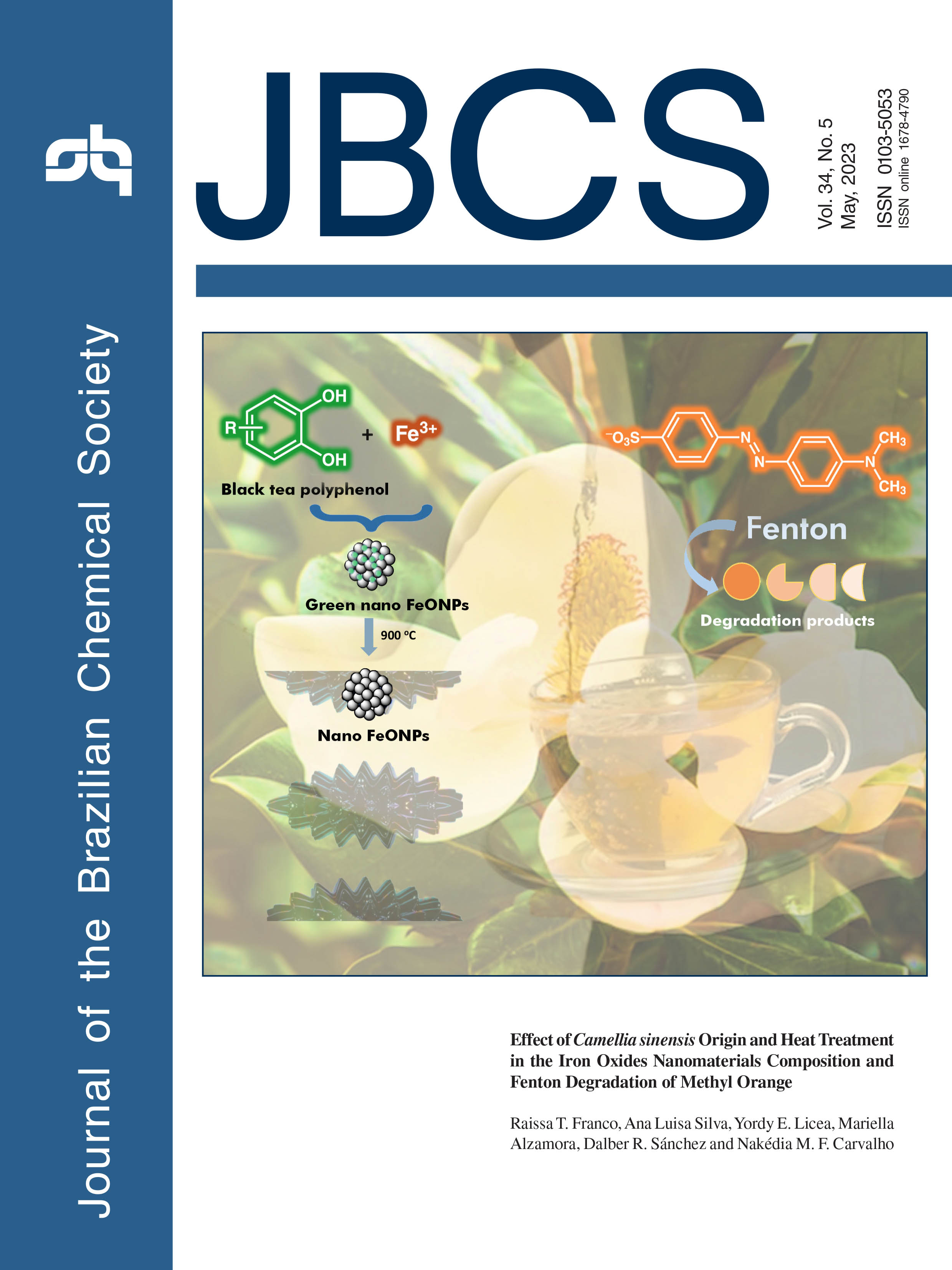vol. 34, No. 5, 2023, p. 615-753
Camellia sinensis extract from different origins were used to prepare iron nanomaterials by a green and sustainable route. Fenton degradation of methyl orange mediated by the nanomaterials led to complete degradation, which was favored by the pH lowering promoted by the polyphenols. The iron oxides obtained after annealing were not so effective, confirming the importance of the polyphenols to enhance Fenton efficiency. Details are presented in the Article Effect of Camellia sinensis Origin and Heat Treatment in the Iron Oxides Nanomaterials Composition and Fenton Degradation of Methyl Orange by Raissa T. Franco, Ana Luisa Silva, Yordy E. Licea, Mariella Alzamora, Dalber R. Sánchez and Nakédia M. F. Carvalho on page 694.
Effect of Camellia sinensis Origin and Heat Treatment in the Iron Oxides Nanomaterials Composition and Fenton Degradation of Methyl Orange
Raissa T. Franco  ; Ana Luisa Silva
; Ana Luisa Silva  ; Yordy E. Licea
; Yordy E. Licea  ; Mariella Alzamora; Dalber R. Sánchez; Nakédia M. F. Carvalho
; Mariella Alzamora; Dalber R. Sánchez; Nakédia M. F. Carvalho
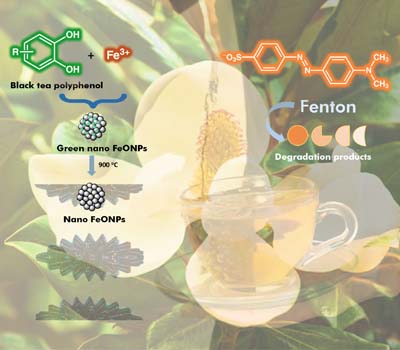
Camellia sinensis extract from different origins were used to prepare iron nanomaterials by a green and sustainable route. Fenton degradation of methyl orange mediated by the nanomaterials led to complete degradation, which was favored by the pH lowering promoted by the polyphenols. The iron oxides obtained after annealing were not so effective, confirming the importance of the polyphenols to enhance Fenton efficiency. Details are presented in the Article Effect of Camellia sinensis Origin and Heat Treatment in the Iron Oxides Nanomaterials Composition and Fenton Degradation of Methyl Orange by Raissa T. Franco, Ana Luisa Silva, Yordy E. Licea, Mariella Alzamora, Dalber R. Sánchez and Nakédia M. F. Carvalho on page 694.
https://dx.doi.org/10.21577/0103-5053.20220140
Review J. Braz. Chem. Soc. 2023, 34(5), 615-640
Combining Fluorescent Quantum Dots with Molecularly Imprinted Polymers for the Screening of both Emerging and Classical Environmental Pollutants: A Review
Shakeel Zeb; Javier E. L. Villa; Ademar Wong; Sabir Khan  ; Sajjad Hussain; Maria D. P. T. Sotomayor
; Sajjad Hussain; Maria D. P. T. Sotomayor
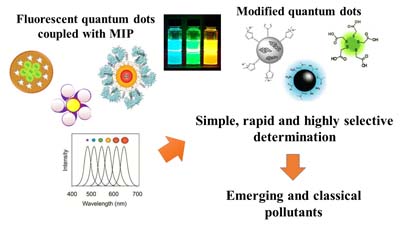
Graphically representation of quantum dots (QDs) coated molecular imprinted polymer sensor for the determination of emerging and classical pollutants. Nanoscale QD materials are suitable for fluorescence analysis. The modification with quantum dots provides many advantages such as rapid detection, highly selective and easily operational.
https://dx.doi.org/10.21577/0103-5053.20230015
Articles J. Braz. Chem. Soc. 2023, 34(5), 641-652
The Use of Single Crystal X-ray Diffraction Technique for Characterization of 25I-NBOMe and 25R-NBOH (R = Cl, I, Br, Et) in Forensic Application
Maria C. C. Lucena; Karen P. S. Lopes; Alejandro P. Ayala; Laura M. T. Vidal; Thiago I. B. Lopes; Nágila M. P. S. Ricardo

The single crystal X-ray diffraction is a non-destructive and promising technique as a qualitative method for identifying benzylphenethylamine substances such as 25I-NBOMe and 25R-NBOH (R = Cl, I, Br, Et).
https://dx.doi.org/10.21577/0103-5053.20220130
J. Braz. Chem. Soc. 2023, 34(5), 653-663
Sugarcane Bagasse Fibers Derivatives and Their Application in Chitosan-Based Composite Films for NPK Fertilizer Release
Lucas Luiz Messa  ; Gabriela Aparecida Contieri; Roselena Faez
; Gabriela Aparecida Contieri; Roselena Faez

Development of biopolymers-based composites from a renewable feedstock for slowing NPK fertilizer release.
https://dx.doi.org/10.21577/0103-5053.20220135
J. Braz. Chem. Soc. 2023, 34(5), 664-672
Baru Seed Extracted Oil (Dipteryx alata Vog.): Chemical Composition and Thermal and Oxidative Stability
Linamarys A. O. Paulo; Raquel N. Fernandes; Kelly M. B. Gandra; Valéria P. R. Minim; Luis A. Minim; Renato Grimaldi; Márcia C. T. R. Vidigal
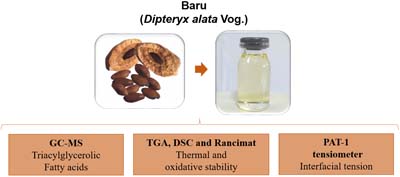
This study investigates the physicochemical properties, chemical and bioactive composition, thermal and oxidative stability, and interfacial properties of baru seed oil, oleaginous species native to the Brazilian Cerrado.
https://dx.doi.org/10.21577/0103-5053.20220136
J. Braz. Chem. Soc. 2023, 34(5), 673-683
Synthesis, Characterization, and Anion Exchange Reactions of Zn2Cr Layered Double Hydroxides Intercalated with Acetate and Chloride
Anne Raquel Sotiles; Marco T. Grassi  ; Mayara P. dos Santos; Luis Gustavo S. Lameu; Fernando Wypych
; Mayara P. dos Santos; Luis Gustavo S. Lameu; Fernando Wypych
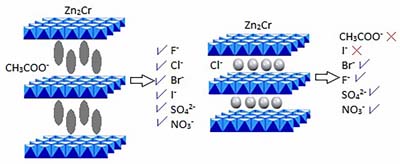
Zn2Cr layered double hydroxides intercalated with chloride or acetate were synthesized and the exchange reactions investigated.
https://dx.doi.org/10.21577/0103-5053.20220137
J. Braz. Chem. Soc. 2023, 34(5), 684-693
Mathematical Mapping Study of Synthetic Antioxidants Behavior in Biodiesel: Application of the Self-Organized Feature Map (SOFM) and Multilayer Perceptron (MLP)
Marco A. J. Clemente; Heloisa H. P. Silva; Julia W. Campos; Nathan F. Silva; Eduardo G. Sousa; Ana C. G. Mantovani; Karina B. Angilelli; Dionisio Borsato
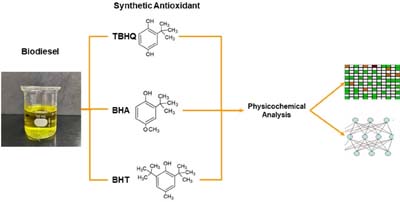
Self-organizing feature maps (SOFM) and multilayer perceptron (MLP) neural networks were applied to evaluate the protection capacity of tert-butylhydroquinone (TBHQ), butylhydroxyanisole (BHA), and butylhydroxytoluene (BHT) antioxidants against the biodiesel oxidation reaction.
https://dx.doi.org/10.21577/0103-5053.20220139
J. Braz. Chem. Soc. 2023, 34(5), 694-704
Effect of Camellia sinensis Origin and Heat Treatment in the Iron Oxides Nanomaterials Composition and Fenton Degradation of Methyl Orange
Raissa T. Franco  ; Ana Luisa Silva
; Ana Luisa Silva  ; Yordy E. Licea
; Yordy E. Licea  ; Mariella Alzamora; Dalber R. Sánchez; Nakédia M. F. Carvalho
; Mariella Alzamora; Dalber R. Sánchez; Nakédia M. F. Carvalho
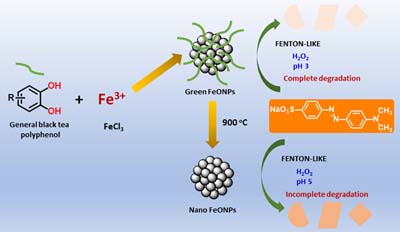
Green iron oxide nanomaterials were prepared from Camellia sinensis extracts of different regions and annealed at 900 ºC, which promoted the phase transformation from amorphous to crystalline α-Fe2O3, FePO4 and Fe3PO7. The as-prepared iron nanomaterials were more efficient in the heterogeneous Fenton degradation of methyl orange due to natural pH lowering to around 3.
https://dx.doi.org/10.21577/0103-5053.20220140
J. Braz. Chem. Soc. 2023, 34(5), 705-712
Production of Silver Nanoparticles Mediated by Aqueous Extracts of Tucumã (Astrocaryum aculeatum) Pulp
Sidney S. dos Santos  ; Ricardo A. A. de Couto; Ingrid R. da Silva; Marcia Regina M. Aouada; Vera R. L. Costantino
; Ricardo A. A. de Couto; Ingrid R. da Silva; Marcia Regina M. Aouada; Vera R. L. Costantino  ; Luiz P. da Costa
; Luiz P. da Costa  ; Gustavo F. Perotti
; Gustavo F. Perotti

Green synthesis of silver nanoparticles mediated by aqueous extracts of tucumã pulp, an Amazonian resource.
https://dx.doi.org/10.21577/0103-5053.20220141
J. Braz. Chem. Soc. 2023, 34(5), 713-724
Extraction Induced by Microemulsion Breaking and Square Wave Voltammetry: A Promising Union to Monitor Cd, Pb and Cu in Biodiesel
Cristian H. Krause  ; Alexandre B. Schneider
; Alexandre B. Schneider  ; Márcia M. da Silva; Marina B. Mazzei; Leandro Kolling
; Márcia M. da Silva; Marina B. Mazzei; Leandro Kolling  ; Fernando N. Leal
; Fernando N. Leal
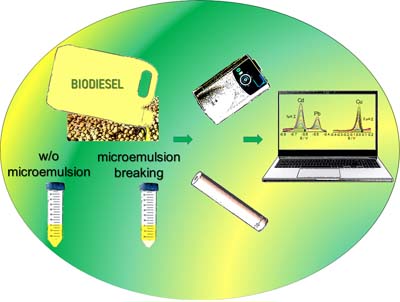
Cadmium, lead and copper determination in biodiesel by square wave voltammetry with portable potentiostat, after extraction induced by microemulsion breaking.
https://dx.doi.org/10.21577/0103-5053.20220142
J. Braz. Chem. Soc. 2023, 34(5), 725-733
Use of Ionic Liquid-Based Ultrasound Assisted Liquid-Liquid Extraction of Phenols from Aqueous Fractions of Seed Bio-Oil
Solange C. A. Cerqueira; Laryssa M. Santos; Antonia R. S. Gois; Cleide M. F. Soares; Brenno A. DaSilveira Neto; Lisiane S. Freitas
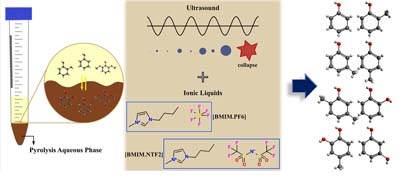
This work investigates the extraction phenols in aqueous-phase pyrolysis of guava seeds, using ultrasonic assisted liquid-liquid extraction with ionic liquids (UALLE-IL).
https://dx.doi.org/10.21577/0103-5053.20220143
J. Braz. Chem. Soc. 2023, 34(5), 734-744
Nickel Nanoparticles Anchored on Bentonite Clay for Methane Decomposition with Ordered Carbon as a Product
Rayssa J. B. Motta  ; Camila B. Dornelas; Rusiene M. de Almeida
; Camila B. Dornelas; Rusiene M. de Almeida
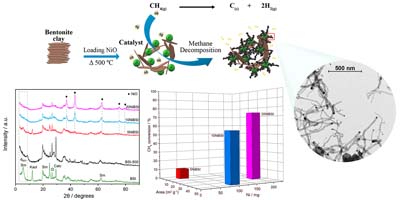
Synthesis and characterization using different nickel oxide concentrations on bentonite to produce ordered carbon by methane decomposition.
https://dx.doi.org/10.21577/0103-5053.20220144
Short Report J. Braz. Chem. Soc. 2023, 34(5), 745-753
Synthesis of Isatins and Oxindoles Derivatives as SARS-CoV-2 Inhibitors Evaluated through Phenotypic Screening with Vero Cells
Cintia M. C. F. Lima; Lúcio H. Freitas-Junior; Carolina B. Moraes; Cecília G. Barbosa; Till Opatz; Mauricio M. Victor
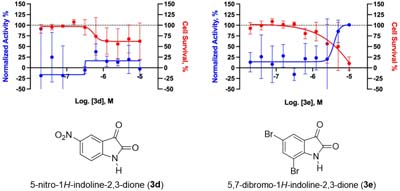
In this work, we performed the synthesis of twenty-seven substituted isatins, 3-hydroxy bis-oxindoles and isoindigos and evaluated against severe acute respiratory syndrome coronavirus 2 (SARS-CoV-2) using a phenotypic screening assay.
https://dx.doi.org/10.21577/0103-5053.20220138
Online version ISSN 1678-4790 Printed version ISSN 0103-5053
Journal of the Brazilian Chemical Society
JBCS Editorial and Publishing Office
University of Campinas - UNICAMP
13083-970 Campinas-SP, Brazil
Free access










